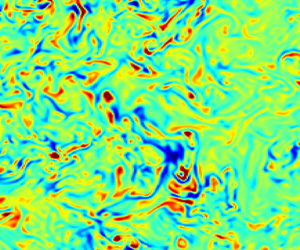Article contents
Effects of thermophoresis on high-pressure binary-species boundary layers with uniform and non-uniform compositions
Published online by Cambridge University Press: 01 December 2022
Abstract

Direct numerical simulations of high-pressure binary-species temporal boundary layers are performed to investigate the flow physics for three situations: (1) uniform and equal composition, (2) uniform but unequal compositions and (3) non-uniform composition. Both colder- and hotter-wall situations compared with the free stream are simulated. The working fluid is a nitrogen/methane mixture. The analysis is performed at a case-specific self-similar state. Even when the initial composition is uniform, the methane mean mass fraction decreases near the colder wall, whereas it increases near the hotter wall and the mass fraction fluctuates in the entire boundary layer. Analysis of the species-mass diffusion balance and flow structures reveal that both mass-fraction variation and fluctuations are induced by the Soret effect. When the initial composition is non-uniform and the wall is colder, the methane mean mass fraction monotonically increases from the wall akin to its initial profile. However, when the wall is hotter the mean mass fraction decreases near the wall in contrast to its initial profile, a fact traced through the species-mass diffusion balance to the Soret effect being large and enriching methane near the wall. In contrast, the direction of the Soret flux is opposite for the colder wall, thus keeping the methane concentration small. Although the initial magnitude of the difference between the wall and free-stream temperature is the same in all cases, the situation is not symmetric between colder- and hotter-wall cases; the flow structure exhibits much smaller scales when the wall is hotter than when the wall is colder.
- Type
- JFM Papers
- Information
- Copyright
- © California Institute of Technology, 2022. Published by Cambridge University Press
References
REFERENCES
- 1
- Cited by





